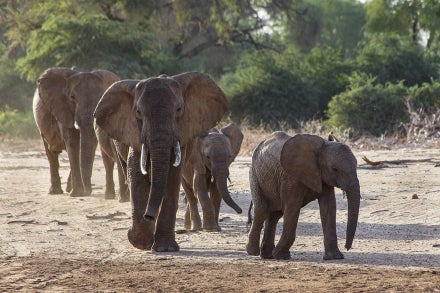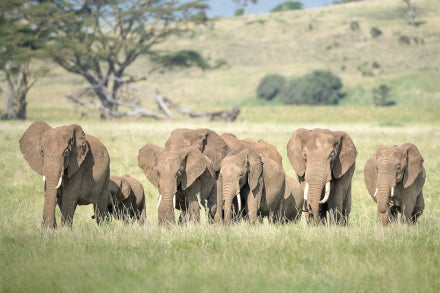FOR IMMEDIATE RELEASE
CONTACT:
San Diego Zoo Wildlife Alliance
Public Relations
619-685-3291
publicrelations@sdzwa.org
WEBSITE:
sdzwa.org
NEWS RELEASE
San Diego Zoo and Its Partners Spearhead Conservation of Critically Endangered Chinese Giant Salamander
Sexing of the Rare Amphibian is Underway, Timed with Its Debut at Wildlife Explorers Basecamp
SAN DIEGO (June 10, 2022) – Chinese giant salamanders are well camouflaged in the rushing waters of China’s mountain river system. Spotting this critically endangered species in its native habitat is exceedingly rare, but guests at the San Diego Zoo now have a unique opportunity to take a close look at this sleek and mysterious creature—at the newly opened Denny Sanford Wildlife Explorers Basecamp. San Diego Zoo Wildlife Alliance and conservation partners, including Ocean Park Hong Kong, are working toward the goal of creating a breeding group of Chinese giant salamanders. The goal is to eventually re-establish depleted populations in the Chinese giant salamander’s native range, while at the same time educating the public about conservation of its habitat in China.
The Chinese giant salamander is the largest living amphibian on the planet, with some measuring nearly 6 feet in length. However, their elusive nature has made it difficult for biologists to study their reproductive habits. Veterinary and wildlife care specialist teams at the San Diego Zoo conducted ultrasounds on three Chinese giant salamanders, in an effort to determine their sex and better understand their overall health. Determining the sex of these individuals is critical to the creation of a conservation breeding plan to help bring this species of “living fossils” back from the brink of extinction. The technique of using ultrasound to determine sex was discovered and recommended by specialists in China and colleagues in the zoo community.
“Using ultrasound will let us see inside the animals, and how their organs are functioning,” said Kim Gray, curator of herpetology and ichthyology at the San Diego Zoo. “Males and females look very, very similar, so ultrasound can help us determine the sex. Researchers throughout the zoo and conservation community are working together, and the techniques that we’re learning are going to help the community at large provide better care for these animals.
“These species are really unique in how they reproduce,” added Gray. “The males and females will breed and produce around 400 to 500 eggs, and the males stay with them. Other than that, there’s not a lot known. We want to learn as much as possible.”
The Chinese giant salamander is listed as Critically Endangered on the International Union for Conservation of Nature (IUCN) Red List of Threatened Species, due to heavy poaching and harvesting for human consumption, despite laws to protect them. Their habitat has become fragmented, and their numbers have plummeted by 80% over the last few decades.
Wildlife Explorers Basecamp at the San Diego Zoo is one of only six locations in the United States where guests can view Chinese giant salamanders. This large amphibian can be seen in the lower level of the Cool Critters building, and is one of many species in the newly opened, 3.2-acre immersive environment designed to inspire empathy for all wildlife, invigorate the next generation of conservationists and, ultimately, help create a world where all life thrives.
###
About San Diego Zoo Wildlife Alliance
San Diego Zoo Wildlife Alliance is a nonprofit international conservation leader, committed to inspiring a passion for nature and working toward a world where all life thrives. The Alliance empowers people from around the globe to support their mission to conserve wildlife through innovation and partnerships. San Diego Zoo Wildlife Alliance supports cutting-edge conservation and brings the stories of their work back to the San Diego Zoo and San Diego Zoo Safari Park—giving millions of guests, in person and virtually, the opportunity to experience conservation in action. The work of San Diego Zoo Wildlife Alliance extends from San Diego to eco-regional conservation “hubs” across the globe, where their expertise and assets—including the renowned Wildlife Biodiversity Bank—are able to effectively align with hundreds of regional partners to improve outcomes for wildlife in more coordinated efforts. By leveraging these skills in wildlife care and conservation science, and through collaboration with hundreds of partners, San Diego Zoo Wildlife Alliance has reintroduced more than 44 endangered species to native habitats. Each year, San Diego Zoo Wildlife Alliance’s work reaches over 1 billion people in 150 countries via news media, social media, their websites, educational resources and the San Diego Zoo Wildlife Explorers television programming, which is in children’s hospitals in 13 countries. Success is made possible by the support of members, donors and guests to the San Diego Zoo and San Diego Zoo Safari Park, who are Wildlife Allies committed to ensuring all life thrives.



